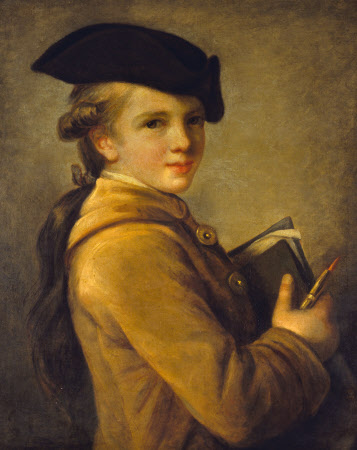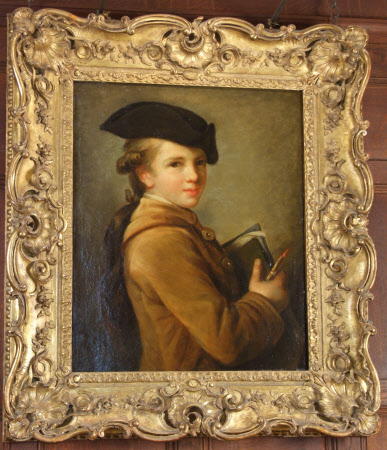A Young Draftsman
after Elisabeth Louise Vigée Le Brun (Paris 1755 – Paris 1842).
Category
Art / Oil paintings
Date
1773 - 1842
Materials
Oil on canvas
Measurements
597 x 495 mm (23 1/2 x 19 1/2 in)
Place of origin
France
Order this imageCollection
Polesden Lacey, Surrey
NT 1246478
Caption
A copy of a painting dated 1773 by Vigée-Lebrun, now in the City Art Museum of St Louis, Missouri. The subject, holding a portfolio and port-crayon (an instrument for drawing with chalk), has traditionally been identified as the artist’s younger brother, Louis-Jean-Baptiste Vigée (1758-1820), although it was most likely conceived as a more generalised depiction of a young draftsman of a type highly popular in eighteenth-century France.
Summary
Oil painting on canvas, A Young Draftsman, after Elisabeth Louise Vigée-Le Brun (Paris 1755 – Paris 1842), after 1773. A half-length portrait of a young boy, turned to the right, his head facing, wearing a light brown coat and black tricorne hat, holding a folio under his left arm and a crayon in his right hand.
Full description
The St Louis picture is signed by Mlle. Vigée and dated 1773. James B. Musick (Bulletin of the City Art Museum of St Louis, XXVI (No.3), 1941, pp. 54-55, repd.) relates that this came from the owners of the Château d'Aigues-Vives, to whose (unnamed) family the artist had originally given the portrait. It is said to represent her younger brother, and, Musick suggests, may be one of the two portraits known to have been painted between 1768 and 1772; these arguments are upheld by Joseph Baillio in exh. cat. Elisabeth Louise Vigée LeBrun, Kimbell Art Museum, Fort Worth, 1982, cat. no.2. There are, however, strong grounds for doubting the traditional identification of the St Louis picture as a portrait of the artist's brother. In the first place, she herself only talks of one likeness of her brother, executed once in oils and once in pastel, which she describes as the first portraits that she ever painted, before even that of her mother in a white pelisse, which she did when she was thirteen and half. This would therefore have been in 1768, when her only brother, Louis-Jean-Baptiste-Etienne (b. 2 Dec. 1758) would have been only nine. Yet the Saint-Louis picture is not only clearly signed and dated 1773, but would appear to be the work of an already accomplished artist, as Mlle. Vigée might well have been when she was seventeen or eighteen (she was established as a professional portrait painter by the time that she was fifteen, in 1770), but scarcely when painting her very first portrait, so young as thirteen. The boy would also appear to be on the threshold of adolescence. There can thus be little case for suggesting, as Baillio does, that the signature and date were added some time after the picture's completion - they also betray none of the marks of this. There is also nothing to explain how this essentially family picture passed from Mme Vigée-LeBrun's or her brother's possession to the (unspecified) owners of the Château d'Aigues-Vives, nor to say whether it was already identified as a portrait of the artist's brother there, or only after it had passed through the hands of Messrs Wildenstein. It would also be curious, in view of the celebrity of the artist and the sentimental associations of such a portrait, that in the case of the Polesden Lacey picture the identity of both artist and supposed subject should have been lost. Mme Vigée-LeBrun refers to the portrait of her brother as showing him 'en écolier', which might or might not mean that he was shown as a young draughtsman, but a portrait (which we cannot now know for certain whether it was by her or not), described as of "the young Vigée.... holding a drawing portfolio under his arm" was in the Pinel-Grandchamp sale in Paris, 13 March 1850, lot 30 (exh. cat. cit., p.33). More certain is a black chalk drawing of Étienne Vigée as a child, shown standing whole-length, and wearing a nightcap, which may have been in the Tripier Le Franc sale (which was that of descendants of her nieces), Paris, 5-7 June 1883, lot 75, and was certainly with the dealer Paul Prouté in 1937, though it has not been seen since. This was signed 'E. L. Vigée', and inscribed 'mon frere'. This may, like the drawing of her mother, have had nothing to do with the portrait in oils; but the description of this last does not self-evidently mean that he was portrayed as a tyro draughtsman, nor can one immediately see why he should have been: he was not trained as an artist as she was (their father died in 1767, and when her mother was married again within the year, it was to a goldsmith). It is much more probable that the present painting was essentially a subject-picture, of a type that Chardin, Boucher, Drouais, Greuze, Lepicié, and -significantly, as a precedent by a woman artist for Mme Vigée Lebrun - Mlle Catherine Lusurier, had made popular (as witness also the false attributions that the various versions have gone under). Whether or not she used her brother as a model is impossible to discover or decide, but the evidence is against it. An X-ray photograph of the St Louis picture shows another head beneath that of the boy, the significance of this, (which Baillio fails to mention) remains to be explored.
Provenance
Said to have belonged to Henry Labouchere, Baron Taunton (1798 - 1869) [it is not, however, mentioned by Gustav Waagen after either of his two visits to the then Rt. Hon. Henry Labouchere's London house (Art Treasures, vol. II, p.287; Galleries & Cabinets, pp.104-5), or on his visit to Stoke Park (Art Treasures, vol II, pp.416-20), even though he did notice a few works of the French School, including 'some very pretty pictures by WATTEAU' at the latter in 1850, and 'A small picture of a girl resting on her arm, from the school of Madame Lebrun' at the former in 1856., and therefore perhaps one of the pictures inherited by his grandson Captain Edward Vesey Stanley, of Quantock Lodge, Bridgwater; date of acquisition by Mrs Greville unrecorded; The bequest of Margaret (Anderson) McEwan, The Hon. Mrs Ronald - later Dame Margaret - Henry Fulke Greville, DBE (1863-1942) from probate records linked with the donation of the property to the National Trust in 1943. This item found on the record for Polesden Lacey pictures, drawings etc., stored in the cellar, page 169.
Makers and roles
after Elisabeth Louise Vigée Le Brun (Paris 1755 – Paris 1842)., artist previously catalogued as attributed to Jean-Siméon Chardin (Paris 1699 – Paris 1779), artist

